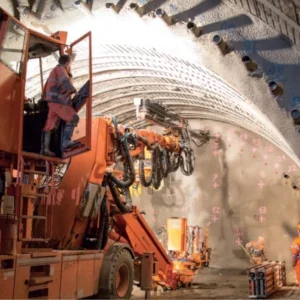Ground risk, inevitably, remains one of the most significant issues for tunnelling and underground construction projects. In extreme cases unmanaged ground risk may result in catastrophic failure and loss of life, yet experience shows even relatively minor project incidents can have a disproportionate impact on construction, safety, programme and costs. These events continue to occur despite considerable technical progress with the investigation, characterisation and mitigation of adverse ground conditions during construction, implying wider project issues play a role.
Project management and organization influence the management of ground related risks. The law approaches these risks and how they may be effectively allocated and managed under a tunneling contract; though there is room for improvement. As with all major or complex projects, the project strategy should inform and be reflected in the contractual approach adopted if ground risks are to be efficiently and effectively managed. Mismatch between strategy and contract form, or failure to consider how risk is managed and allocated, frequently lead to project distress and construction disputes.
Project management
The incidence of major tunnel failures remains stubbornly high, particularly in the urban environment. The Nicoll Highway failure in 2004 had a number of similarities to the Heathrow collapse 10 years earlier; more recently major incidents have occurred in 2007 at Pinheiros during construction of the Sao Paulo metro and during extension of the Köln metro in 2009.
A significant factor in the Pinheiros collapse and the earlier incidents was found to be systemic failure of project organisation and management.
Project ground risk and the attendant cost and time impacts will, to varying degrees, be contractually owned by both the contractor and client body. All parties involved in the management of the project can influence how this significant issue is addressed and should play an active role in the continuous review, mitigation and management of this risk. Project culture, partnering arrangements and a genuine cooperative approach to risk management yield significant benefits.
In the first section of this article various ways in which ground risk may be dealt with practically and through effective project management and organisation are discussed.
Risk management
Following the Heathrow collapse, the UK Health and Safety Executive (HSE) concluded that a formal “risk based approach to design, construction and management” was required. The subsequent application of more rigorous risk management principles—including the use of the Construction, Design and Management Regulations—has had a significant and positive impact on the industry in the last 15 years.
Risk registers for tunnelling and underground construction projects are now routinely used and frequently they refer to adequate site investigation as a risk control measure for excavation stability. It is not common however to see rigorous risk management principles applied specifically to the issue of ground risk and how this can be best managed. As an inevitable project risk, the ground should be the subject of a separate risk assessment identifying the full range of potential hazards and recommending how these are either eliminated or mitigated.
The Association of British Insurers/British Tunnelling Society Joint Code of Practice for Risk Management of Tunnel Works is now a requirement of insurance cover for most major projects. It covers a wide range of issues throughout the project cycle, including specific measures to address ground risk. Importantly, the insurers regularly audit projects to ensure compliance with the code. The joint code is increasingly used as a wider project management tool to ensure industry best practice and standards are applied on projects.
Site investigation
As ground risk is a consequence of inadequate understanding—principally of the distribution and behaviour of natural materials, although obstructions may be a greater hazard—it is important to conduct a site investigation whose scope matches the complexity and risk profile of the project.
One of the most common issues concerning site investigation is that this important activity is not procured early enough in the project cycle, and that inadequate resources and budget are allocated to it. This frequently results in increased risk during the tender, design and construction phases of the project.
Good site investigation data are of limited value if not correctly interpreted. Properly interpreted site investigation data form the basis for good design and are vital for ground risk management during construction. Adequate time, budget and resources need to be allocated to this important task early enough in the project cycle to inform subsequent stages, either by the client or contractor in a design and build situation.
Geotechnical Baseline Reports (GBR), increasing applied outside the USA, are used for the contractual allocation of risk and a basis for determining the contractor’s entitlement to additional time and money in relation to ground conditions. Although not a design document, being typically prepared by the engineer, GBRs assist with the understanding and interpretation of factual site investigation data.
It is important that the site investigation process should continue during the construction phase, typically involving ground probing and investigation that may be combined with ground treatment. This should be written into the contract, especially where ground conditions are complex and or the construction method warrants it.
Design
Ground risk can be mitigated by requiring fully-engineered designs for all stages of the excavation and construction cycle. This was an important conclusion of the HSE reports into the Heathrow collapse. Empirical or semi-empirical designs, although necessary in certain situations such as very deep tunnels, do not adequately manage ground risk and are not used in the UK.
Consequential ground risks may exist, particularly in urban areas where underground construction results in ground settlement that impacts sensitive third-party assets such as rail infrastructure or historic buildings. Other examples include tunnelling near to or through aquifer Source Protection Zones. The additional time and cost to the project of managing third party interfaces, gaining approvals, etc. can be very significant and should not be underestimated.
Construction methodology
The construction methodology, including the use of additional support measures where required for stability, should have the flexibility to deal with the full range of anticipated ground conditions.
Monitoring is an essential aspect of underground construction and ground risk management. Effectively used it verifies that the ground is behaving in accordance with the design assumptions. The wider project organisation needs to ensure that adequate resources exist to gather and interpret monitoring data, and that robust emergency procedures and contingency plans exist if pre-defined trigger levels are exceeded.
Ground treatment can be effectively used to eliminate ground risk at source, either applied systematically from the surface or as part of the excavation cycle combined with ground probing and investigation during construction. The relative costs and time impacts of these two options on construction logistics and programme need management assessment.
Contract mechanisms such as Early or Optimised Contractor Involvement bring constructor experience to the project before design is finalised. Although the main purpose is to explore project cost and time efficiencies the process can also bring to light risk issues through construction experience in similar ground conditions, the appropriateness of construction methodology, equipment, etc.
The general legal background
The general principle under English law is that the contractor, unless his contract stipulates otherwise, carries the risk of adverse ground conditions, regardless of whether they were foreseeable at the time of tender.
This rule applies even if information provided by the employer at tender stage and perhaps later incorporated into the contract—e.g. site investigations or drawings, plans and specifications—proves inaccurate. English law does not imply a warranty from the employer that such information is correct.
Generally, the law will find that the contractor has satisfied himself as to the feasibility of the works and undertaken to complete them according to the terms of the contract. It will be a breach of contract if he fails to do so. It follows that he must bear any additional costs necessitated by unforeseen ground conditions.
A contractor may be able to argue, on particular facts, that the employer has warranted that the ground conditions will be as specified in the tender documents. However, many employers will seek to exclude any such warranties.
A contractor may also be able to claim damages from an employer on the basis that the employer has misrepresented something (e.g. particular sub-surface conditions) on which the contractor has relied to his detriment. But, in most cases, it will be difficult or impossible for the contractor to justify an action for misrepresentation.
The approach of the English courts to the allocation of risk for ground conditions has been followed in a number of other jurisdictions including Canada and New Zealand.
Ground conditions in standard form contracts
Unsurprisingly, the common law rule is widely seen as simplistic and potentially unfair—particularly in relation to major or complex civil engineering projects, where typically the employer will have undertaken detailed ground investigations before inviting tenders. As a result, standard form contracts designed for use in the civil engineering sector frequently include provisions that attempt to promote a more balanced approach to the allocation of ground risk.
For example, the ICE 7th Edition provides that:
• The contractor is only required to take into account information on ground conditions obtained by the employer to the extent that it was made available to the contractor prior to tender submission
• The contractor is deemed to have inspected the site and “satisfied himself so far as is practicable and reasonable” prior to tendering as to all risks (including ground risks) that may affect his tender
• If “physical conditions,” which includes ground conditions, though the term is of wider application, are encountered during the works that the engineer decides an experienced contractor could not reasonably have foreseen, the contractor is entitled to additional payment and an extension of time in relation to these conditions
The detailed application of the relevant ICE clauses (11 and 12) has given rise to debate amongst lawyers. Undoubtedly, however, they represent a considerable readjustment of risk allocation in favour of contractors.
The International Federation of Consulting Engineers (other than the Silver Book for EPC/turnkey projects) and IChemE contract suites contain similar provisions to those found in the ICE 7th Edition.
The NEC3 Engineering and Construction Contract (ECC) adopts a similar approach. It provides (clause 60) that the contractor is entitled to a compensation event in relation to “physical conditions” that “an experienced contractor would have judged at the [date on which the contract came into existence] to have such a small chance of occurring that that it would have been unreasonable to have allowed for them.”
For the purpose of the project manager’s assessment of the compensation event, the contractor is assumed to have taken into account:
• Site information specified in the contract data
• Publicly available information referred to in the site information
• Information obtainable from a visual inspection of the site
• Other information which an experienced contractor could reasonably be expected to have or obtain
Whilst these standard forms each attempt to set out a more balanced approach to allocation of ground risk—which may lead, as NEC3 is intended to do, to more efficient contract pricing, with the contractor not being driven to include a risk premium in relation to risks which he is unable to quantify—each can be criticised for not being more sophisticated. Indeed, ECC’s approach to ground conditions has been criticised by one distinguished tunneling engineer (Sir Alan Muir Wood) as falling short of “good practice.” The criticism applies equally to the other standard forms.
The key issue is, of course, that none of these forms requires risk allocation to be measured against a detailed technical baseline.
As a result, it may be said that they do not go far enough in promoting the rigorous analysis and allocation of ground risks. Instead, they require the engineer or project manager to make a largely subjective assessment of what the “experienced contractor” could reasonably have foreseen—an assessment that may have a critical impact on a project’s budget, programme and deliverability, not to mention on the parties’ behaviour.
Contract solutions
It is, perhaps, surprising that the standard forms have not gone further. Certainly, a number of important tunnelling industry papers have promoted a more sophisticated approach to the identification and handling of project risk, both at project inception and during the works themselves.
As long ago as 1979, CIRIA published Tunnelling—improved contract practices, which promoted the use of GBRs. More recently, the Joint Code similarly advocated the use of GBRs and followed the American Society of Civil Engineers’ GBRs for underground construction (1997).
A GBR is a detailed statement of ground conditions that is typically produced by the employer and used for tendering and, if incorporated into the contract terms, contract management. It sets out, as objectively as possible, a description of geotechnical conditions that are anticipated or assumed will be encountered during the works. For example, it may specify assumptions as to the level of the water table, the incidence of fissures or the amount of flint in chalk.
A GBR allows each tendering contractor to price a uniform set of assumed or forecast ground risks, promoting a more ready comparison of tenders and, prior to commencing the works, a measured contractual allocation of ground condition risk. The employer will retain cost and time risk for conditions that are more adverse than those specified in the GBR; the contractor takes the risk in relation to conditions that are no more adverse.
When referenced in the ground risk clauses of the contract, the GBR will provide the engineer or project manager with the means—missing from the standard forms—for deciding in an objective manner whether or not the actual conditions encountered entitle the contractor to additional money and an extension of time. In theory, this should lead to a reduced likelihood of disputes between the parties in relation to ground conditions.
In recent years GBRs have become an increasingly common feature of tunneling contracts in the UK and internationally. In part, this reflects practice in the US. It is also a development that is being promoted by a range of industry stakeholders, including insurers. GBRs are now increasingly being used on a number of major tunnelling contracts within the UK.
Other contractual mechanisms relevant to ground risk
There are two broad elements to ground risk management in tunnelling contracts. The first is the initial, contractually-binding allocation of cost and time risk in relation to unforeseen ground conditions. The second is the continuous management of ground risk throughout a project’s life.
The latter is an aspect of project management in its broad sense and can be realised through tools such as risk registers and the establishment of a culture of cooperation and integrated teamworking. It is worth emphasising here that a risk register is a tool for managing risk; it is not a means by which risk itself is allocated. It may be said that the standard forms, generally speaking, do relatively little to promote the adoption of such ways of working.
The obvious exception is the ECC, which requires a risk register to be maintained and risk reduction meetings to be held and generally seeks to promote at its core proactive risk management. It is another matter how successful the ECC always is in practice. But the embedding of these techniques and ways of thinking into the contract obviously aligns with and serves to promote behaviours that drive successful project outcomes.
Conclusions
The management and efficient allocation of ground risk will be improved by an early and adequate assessment of ground conditions. The scope of site investigation commissioned should be appropriate to the nature, complexity and value of the project. Increasingly, such assessments are being included in tunnelling contracts as GBRs, which allow for the allocation of ground risks between the employer and contractor to be made objective.
This increased transparency of risk ownership translates into a simpler, less contentious resolution of contract claims arising out of unforeseeable ground conditions.
At present no standard form contract directly promotes the use of GBRs. Bespoke drafting is required in order to achieve this contractual position.
Effective ongoing ground risk management throughout the life of a project requires the adoption of project management tools including monitoring, the use of risk registers and early warning systems. Most standard form contracts do not promote the use of these tools, despite the fact that they are now very well established. Even where they are provided for in a tunnelling contract, the culture of the project must nevertheless be actively developed and sustained so as to ensure that the benefits such tools can deliver are realised.
The Nicoll Highway collapse in 2004






